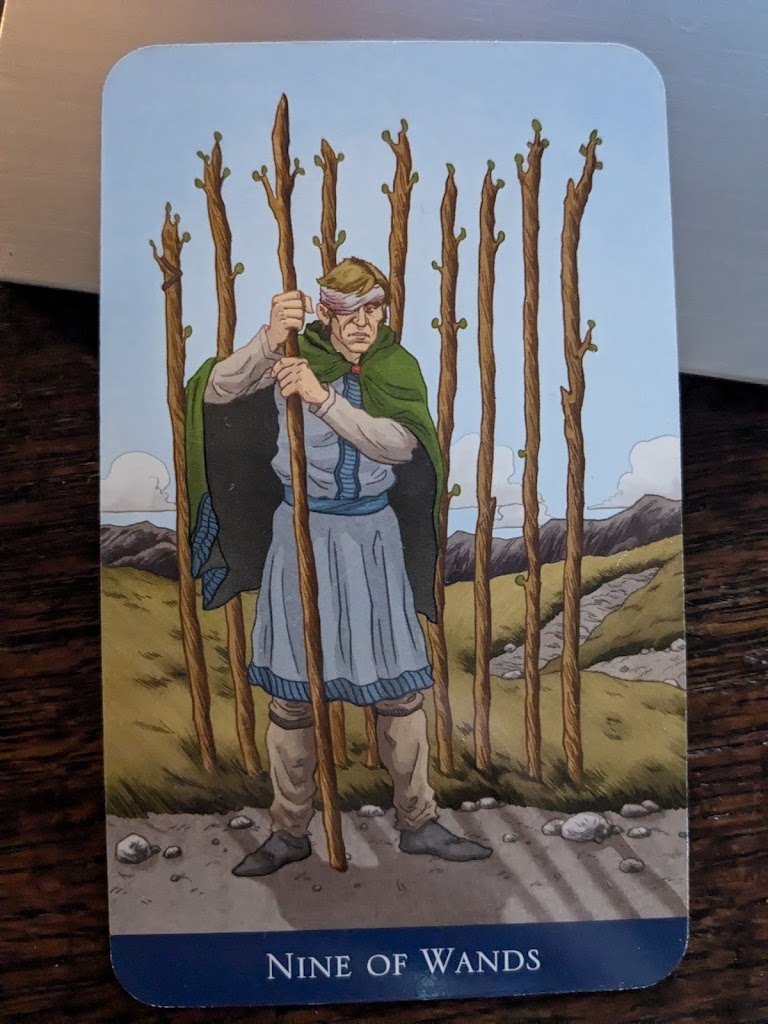Day 13: Nine of wands Reversed
He’s resolute and ragged. He grips his staff (a wand) with both hands for support. He’s worn out; he’s done. And yet….he is still standing and the 8 other wands behind him stand as a barricade against any further battle. A bloody bandage covers part of his head and one eye; he perhaps lacks full understanding, but it’s hard to see the complete picture when consumed by exhaustion at the end of a battle. Maybe his physical sight and senses aren’t what’s needed right now.
He seems to be in a similar place as Gerard Manley Hopkins’ speaker in “Carrion Comfort.” “I can no more; I can” he cries as he emerges from wallowing in “Despair.” He’s at a place of both looking back and looking forward; in his forward search he hopes for “hope” and to choose not to kill himself. But he remembers the “lionlimb” that battered him as he surveys his “bruised bones.”
But the wands in the image say what he’s doing is worth it. As Hopkins’ speaker questions the purpose of his suffering, he remembers “cheer,” but it’s short lived, for he immediately asks “Cheer whom though?” The very one who brought this on him in the first place? Or should he cheer himself for his own resilience?
I’m going to jump now to a very different poem, one by Kimiko Hahn called “Resilience,” for the Nine of Wands reversed points me toward the inner experience of this story, that is, not so much the man’s physical appearance, but his inner strength. Most of Hahn’s poem the speaker leads us through descriptions of how something as small as a mosquito can withstand the weight of a single water drop, something “fifty times as much” as the mosquito weighs. It goes “with the flow.” And robots, too, the speaker says, people have found that if you make them small enough, “you basically don’t have to do anything else//to make it survive.” The poem ends by likening all this to someone who has a “happy-go-lucky heart even though//his mother was strangled when he was seven.”
Hahn’s poem compares the shell of a mosquito, an outer protection, to a man’s inner fortitude—his “happy-go-lucky heart.” Thus, how we think of ourselves can be like that “exoskeleton” that opens a path beyond the despair of Hopkins’ speaker, or indeed someone who lost his mother by strangulation when seven years old. Though the man in the Nine of Wands is clearly not “happy-go-lucky” at the moment, with the strength of the eight wands behind him—his mental strength, in a way—he can push through, maybe without ending his own life, maybe even with hope.
Bibliography:
Hahn, Kimiko. “Resilience.” Poetry Foundation. https://www.poetryfoundation.org/poems/161078/resilience
Hopkins, Gerard Manley. “Carrion Comfort.” Poetry Foundation. https://www.poetryfoundation.org/poems/44392/carrion-comfort
(My Tarot deck is Llewellyn’s Classic Tarot by Barbara Moore and illustrated by Eugene Smith.)

